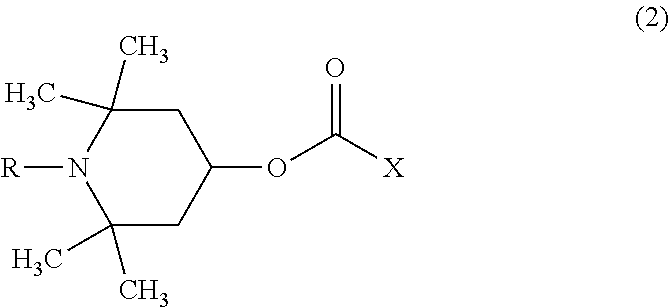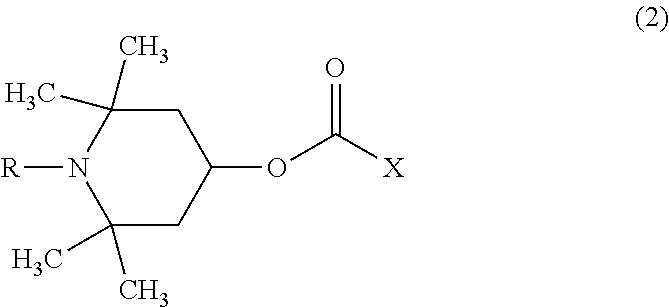Polymerizable composition for optical materials
- Summary
- Abstract
- Description
- Claims
- Application Information
AI Technical Summary
Benefits of technology
Problems solved by technology
Method used
Image
Examples
example 1
[0094]75.0 parts by mass of bis(β-epithiopropyl)sulfide as the compound (a), 11.3 parts by mass of m-tetramethyl xylylene diisocyanate as the compound (b), 13.7 parts by mass of m-xylylenedithiol as the compound (c) and 0.025 part by mass of pentamethylpiperidyl methacrylate as the compound (d) were mixed together and subjected to a thiourethanation preliminary reaction at 20° C. for 16 hours, and it was confirmed that the consumption of the isocyanate group of the compound (b) was 80% by FT-IR. Further, it was confirmed that the consumption of the episulfide group was less than 1% by FT-IR. The viscosity of the preliminary reaction solution at 20° C. was 50 cP. With this preliminary reaction solution, 0.025 part by mass of tetrabutylphosphonium bromide as a polymerization catalyst, 0.01 part by mass of dibutyltin dichloride as a polymerization modifier and 1.0 part by mass of 2-(2-hydroxy-5-tert-octylphenyl)benzotriazole as a ultraviolet absorber were mixed to produce a homogeneous...
example 2
[0096]80.0 parts by mass of bis(β-epithiopropyl)sulfide as the compound (a), 8.4 parts by mass of m-tetramethyl xylylene diisocyanate as the compound (b), 11.6 parts by mass of m-xylylenedithiol as the compound (c), 0.025 part by mass of pentamethylpiperidyl methacrylate as the compound (d) and 1.0 part by mass of 2-(2-hydroxy-5-tert-octylphenyl)benzotriazole as a ultraviolet absorber were mixed together and subjected to a thiourethanation preliminary reaction at 25° C. for 10 hours, and it was confirmed that the consumption of the isocyanate group of the compound (b) was 76% by FT-IR. Further, it was confirmed that the consumption of the episulfide group was less than 1% by FT-IR. The viscosity of the preliminary reaction solution at 20° C. was 45 cP. With this preliminary reaction solution, 0.020 part by mass of tetrabutylphosphonium bromide as a polymerization catalyst was mixed to produce a homogeneous polymerizable composition. The obtained polymerizable composition was subject...
example 3
[0098]50.0 parts by mass of bis(β-epithiopropyl)sulfide as the compound (a), 28.3 parts by mass of m-tetramethyl xylylene diisocyanate as the compound (b), 21.7 parts by mass of m-xylylenedithiol as the compound (c), 0.050 part by mass of pentamethylpiperidyl methacrylate as the compound (d) and 1.0 part by mass of 2-(2-hydroxy-5-tert-octylphenyl)benzotriazole as a ultraviolet absorber were mixed together and subjected to a thiourethanation preliminary reaction at 30° C. for 6 hours, and it was confirmed that the consumption of the isocyanate group of the compound (b) was 70% by FT-IR. Further, it was confirmed that the consumption of the episulfide group was less than 1% by FT-IR. The viscosity of the preliminary reaction solution at 20° C. was 80 cP. With this preliminary reaction solution, 0.025 part by mass of tetrabutylphosphonium bromide as a polymerization catalyst and 0.02 part by mass of dibutyltin dichloride as a polymerization modifier were mixed to produce a homogeneous ...
PUM
| Property | Measurement | Unit |
|---|---|---|
| Percent by mass | aaaaa | aaaaa |
| Percent by mass | aaaaa | aaaaa |
| Ratio | aaaaa | aaaaa |
Abstract
Description
Claims
Application Information
 Login to View More
Login to View More - R&D
- Intellectual Property
- Life Sciences
- Materials
- Tech Scout
- Unparalleled Data Quality
- Higher Quality Content
- 60% Fewer Hallucinations
Browse by: Latest US Patents, China's latest patents, Technical Efficacy Thesaurus, Application Domain, Technology Topic, Popular Technical Reports.
© 2025 PatSnap. All rights reserved.Legal|Privacy policy|Modern Slavery Act Transparency Statement|Sitemap|About US| Contact US: help@patsnap.com



